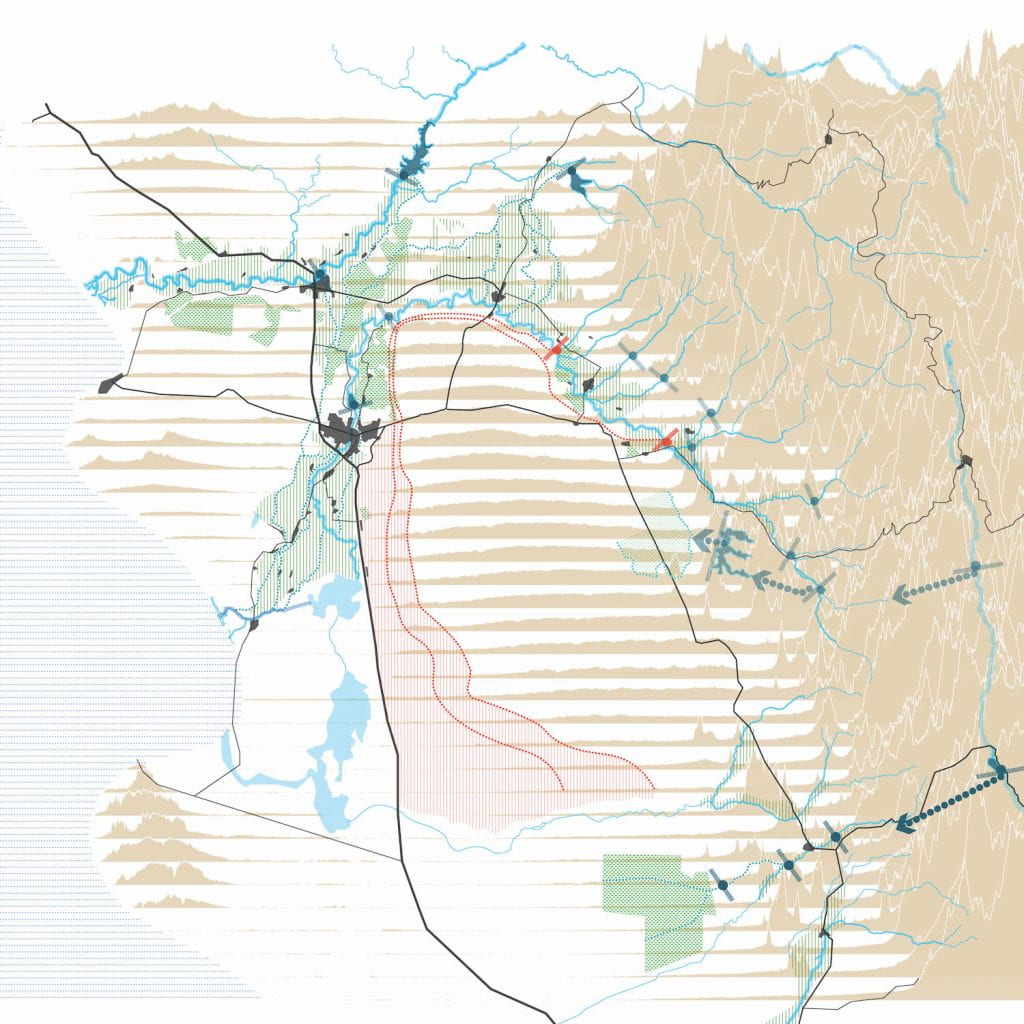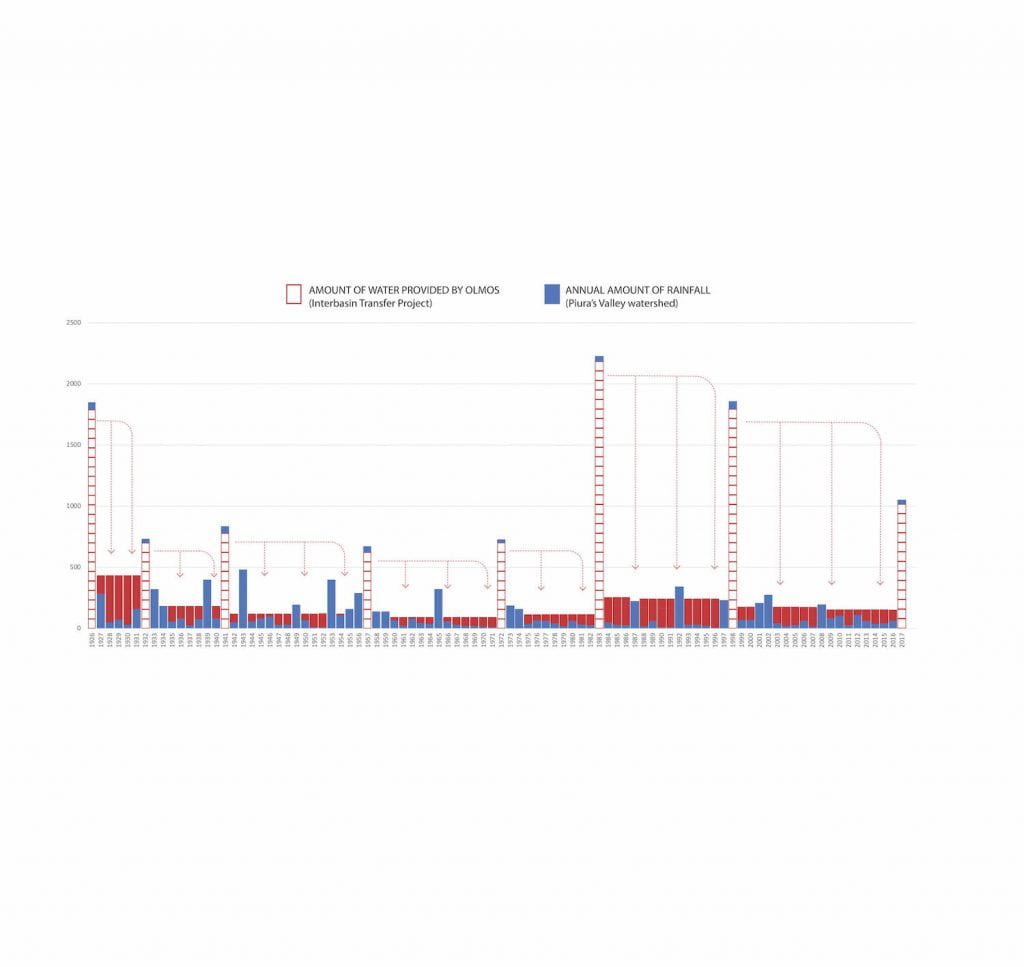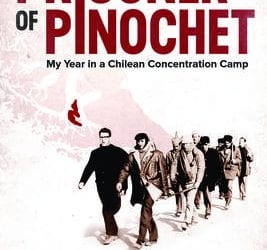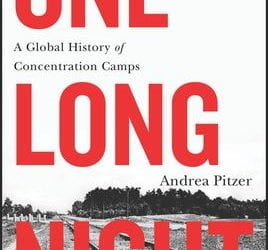Extreme Hydraulic Urbanism
Reframing Water Management on the Peruvian Coast

Map and precipitation history of Piura’s territory contrasting the potential of rainfall’s storage capacity of El Niño cycles and government’s current or future projects of flood defense and interbasin transfer. Chart by Gustavo Diaz Paz
Growing up on Peru’s coast, we are always told as children that we don’t have enough water and that we shouldn’t waste it. But we also learn to get used to disasters, especially El Niño, which brings large amounts of water that cause floods and arrive every decade—at least once in the early life of every Peruvian child. And one out of two Peruvians live on its extensive coast, which has a desert climate. Scarcity and overabundance of water exist for us at the same time.
Most of our coastal regions bring water from the Andean valleys or the Amazon basin for agriculture and urban consumption by using costly infrastructure. But should we consider the possibility that our public policies to manage water and prevent disasters are ill-fitted to our territory’s requirements?
Certainly, in Peru, a postcolonial country, our concepts of urbanism and management of territory derive from the legacy of the western approach which was inevitably influenced by the western territory. In terms of water and weather, western patterns of seasons and rainfalls periods are very different. Peru and other nations within the tropics do not have four seasons or periods of stable rainfall.
The ancient societies in Peru, as well as the other greatest ancient societies in the world, had to adapt to their territory. Historian Karl Wittfogel asserts that effective management of water was a key to the flourishing of the greatest societies in the ancient world, what he called Hydraulic Societies—civilizations in Egypt, China, India, Mexico, Mesopotamia and Peru. These societies experienced different weather conditions from those of colonizing nations. Many factors influenced these so-called hydraulic societies such as their tropical location and/or ENSO (El Niño South Oscillation). El Niño, for example, is one of the greatest influencers in the weather of the Pacific Ocean basin, as well as conditions in Western Africa (drought periods) and India (monsoons), which make up a large area of the world. ENSO causes their weather variations so that it can produce a diverse intensity of either droughts or floods in the same place in different years. Our territories do not have extreme changing scenarios, but our scenarios are extreme; our nature is the constant change.
Presumably, ancient societies considered their weather conditions normal, not unstable, and events like monsoons or El Niño were not considered disturbances or disasters but part of their territorial cycle. They knew how to deal with their local assets and limitations. They faced droughts by taking advantage of sustainable measures such as aquifers, creating filtration galleries or qanats in Jordan or Peruvian desert civilizations; they dealt with floods by creating agricultural patterns of ridged fields in Colombian valleys; they developed agriculture with dynamics that anticipated weather extremes such as floating agriculture in Bangladesh or chinampas in Mexico. They dealt with shifting rainfall scenarios by creating storage devices which would be useful in dry years such as dams and percolation grounds coupled with wells; the best examples are the stepwells and dams in India. Could you imagine how a territory conquered by Aztecs or Mesopotamians in Europe would have looked? What would the management of territory have been like? Water bodies filled with chinampas and rivers’ flood plains converted into ridged fields.
The western approach embedded many mismatches of water management in our territories because the colonizers had base concepts informed by a different context. Harvard professor of economy and history David Landes asserted, “Tropical areas generally average enough rainfall, but the timing is often irregular and unpredictable, the downpours are anything but gentle. The averages mean nothing when one goes from one extreme to the other, from one year or one day to the next.” Yet most of the decision-makers in our regions based their policies on the average annual rainfall, as was the western approach. Instead, we ought to break down the annual historical precipitation to look for opportunities and manage our limitations. We must reframe our mindsets about our territories. What if our mindset realizes our extreme conditions are normal? Then, what would be done? What are the opportunities and the mismatches?
My ongoing thesis seeks to reframe the approach to the water in Piura’s valley, the most damaged Peruvian region in the 2017 El Niño. The National Government proposed a flood protection plan which focuses on short-term solutions: taking out new sediments from the river channel that would quickly divert the river flow to the sea. This sounds paradoxical in an arid area needing to increase water availability, throwing away blue gold to the sea. In the next severe El Niño, Piura’s river will continue to carry large amounts of sediments, raising the bed of the river channel and increasing flood vulnerabilities again.
On the other hand, Piura is also struggling with expanding its agricultural frontier since the current capacity is not enough. The Peruvian government has sought to increase the productive land area interbasin transfer projects, such as Olmos Irrigation Project, which brings water from the Amazon basin by a tunnel that cuts across the Andes, the Olmos project provides 20,000 jobs and 100,000 acres for agriculture; however, this type of project is highly expensive and takes long time. Here is again the paradox of current strategies: dealing with the abundance and scarcity of water.
By understanding the local dynamics of precipitation in Piura’s watershed through history, my thesis project envisions a proposal that tackle at the same time flood protection and water supply. Given the extremely variable amount of annual rainfall, many questions arise: What would have happened if we would have stored all the drops in wet years? Can we use as much water to avoid interbasin transfer projects that are costly and ecologically harmful? Can the collection of rainfall be useful for flood protection? Water storage is the key to finding answers to all these questions. Ancient societies deployed an array of systems by managing superficial water (dams) and aquifers (which are considered “naturally built dams”).
My thesis uses as a point of reference the new amount of water supply to be produced by the Olmos Interbasin Transfer project, as well as its cost implications. The objective is to propose an alternative plan that could not only increase water availability and result in benefits to the regional economy, but also accomplish flood defense necessities through a project that would be more economically efficient and ecologically sustainable. In addition, it would help to restore the water cycle by the aquifers recharge which will help to recover the local forest whose keystone species such as the Algarrobo tree depend on groundwater. The water infrastructure, such as the percolation basins or ponds, also could be used as temporary agriculture or floating agriculture by villagers, depending on the shift between dry or wet years, as ancient societies did.
Due to climate change, contemporary challenges seem more complicated; dry years or arid regions will be drier and wet years or rainy regions will be wetter. Peruvian coast must face these new contexts appropriately, based on a real understanding of its territory dynamics.
Spring/Summer 2018, Volume XVII, Number 3
Gustavo Diaz Paz is a Master in Urban Design candidate at the Harvard Graduate School of Design. He graduated as an architect from Pontificia Universidad Catolica del Peru. His research focuses on water in the interplay of Urbanism, Landscape and Ecology; he has been researching mostly in territories of extreme water dynamics such as India, the Middle East, California and Peru.
Related Articles
Words that Matter
Those of us with little children often read The Lorax by Dr. Seuss to them at bedtime. The story points toward the past, because the Lorax is a ruin, with only residues remaining of something…
Prisoner of Pinochet: My Year in a Chilean Concentration Camp
English + Español
On September 11, 1973, at about eight o’clock in the morning, Sergio Bitar, one of Allende’s top economic advisers and the Minister of Mining, received a phone call from a colleague: the
One Long Night: A Global History of Concentration Camps
English + Español
In One Long Night: A Global History of Concentration Camps, Andrea Pitzer offers a thoughtful combination of investigative journalism and historical analysis that identifies the roots and





